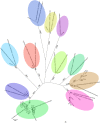Identifying the "Mushroom of Immortality": Assessing the Ganoderma Species Composition in Commercial Reishi Products
- PMID: 30061872
- PMCID: PMC6055023
- DOI: 10.3389/fmicb.2018.01557
Identifying the "Mushroom of Immortality": Assessing the Ganoderma Species Composition in Commercial Reishi Products
Abstract
Species of Ganoderma, commonly called reishi (in Japan) or lingzhi (in China), have been used in traditional medicine for thousands of years, and their use has gained interest from pharmaceutical industries in recent years. Globally, the taxonomy of Ganoderma species is chaotic, and the taxon name Ganoderma lucidum has been used for most laccate (shiny) Ganoderma species. However, it is now known that G. lucidum sensu stricto has a limited native distribution in Europe and some parts of China. It is likely that differences in the quality and quantity of medicinally relevant chemicals occur among Ganoderma species. To determine what species are being sold in commercially available products, twenty manufactured products (e.g., pills, tablets, teas, etc.) and seventeen grow your own (GYO) kits labeled as containing G. lucidum were analyzed. DNA was extracted, and the internal transcribed spacer (ITS) region and translation elongation factor 1-alpha (tef1α) were sequenced with specific fungal primers. The majority (93%) of the manufactured reishi products and almost half of the GYO kits were identified as Ganoderma lingzhi. G. lingzhi is native to Asia and is the most widely cultivated and studied taxon for medicinal use. Illumina MiSeq sequencing of the ITS1 region was performed to determine if multiple Ganoderma species were present. None of the manufactured products tested contained G. lucidum sensu stricto, and it was detected in only one GYO kit. G. lingzhi was detected in most products, but other Ganoderma species were also present, including G. applanatum, G. australe, G. gibbosum, G. sessile, and G. sinense. Our results indicate that the content of these products vary and that better labeling is needed to inform consumers before these products are ingested or marketed as medicine. Of the 17 GYO kits tested, 11 kits contained Ganoderma taxa that are not native to the United States. If fruiting bodies of exotic Ganoderma taxa are cultivated, these GYO kits will likely end up in the environment. The effects of these exotic species to natural ecosystems needs investigation.
Keywords: Ganoderma lucidum; Polyporales; dietary supplements; lingzhi; reishi.
Figures



Similar articles
-
Elucidating "lucidum": Distinguishing the diverse laccate Ganoderma species of the United States.PLoS One. 2018 Jul 18;13(7):e0199738. doi: 10.1371/journal.pone.0199738. eCollection 2018. PLoS One. 2018. PMID: 30020945 Free PMC article.
-
Distinguishing commercially grown Ganoderma lucidum from Ganoderma lingzhi from Europe and East Asia on the basis of morphology, molecular phylogeny, and triterpenic acid profiles.Phytochemistry. 2016 Jul;127:29-37. doi: 10.1016/j.phytochem.2016.03.012. Epub 2016 Apr 1. Phytochemistry. 2016. PMID: 27044336
-
Comparative studies of various ganoderma species and their different parts with regard to their antitumor and immunomodulating activities in vitro.J Altern Complement Med. 2006 Oct;12(8):777-89. doi: 10.1089/acm.2006.12.777. J Altern Complement Med. 2006. PMID: 17034284
-
Ganoderma lucidum (Lingzhi or Reishi): A Medicinal Mushroom.In: Benzie IFF, Wachtel-Galor S, editors. Herbal Medicine: Biomolecular and Clinical Aspects. 2nd edition. Boca Raton (FL): CRC Press/Taylor & Francis; 2011. Chapter 9. In: Benzie IFF, Wachtel-Galor S, editors. Herbal Medicine: Biomolecular and Clinical Aspects. 2nd edition. Boca Raton (FL): CRC Press/Taylor & Francis; 2011. Chapter 9. PMID: 22593926 Free Books & Documents. Review.
-
From 2000years of Ganoderma lucidum to recent developments in nutraceuticals.Phytochemistry. 2015 Jun;114:56-65. doi: 10.1016/j.phytochem.2015.02.015. Epub 2015 Mar 17. Phytochemistry. 2015. PMID: 25794896 Review.
Cited by
-
Competitive antagonistic action of laccase between Trichoderma species and the newly identified wood pathogenic Ganoderma camelum.Front Microbiol. 2024 Sep 25;15:1408521. doi: 10.3389/fmicb.2024.1408521. eCollection 2024. Front Microbiol. 2024. PMID: 39386367 Free PMC article.
-
Nutritional Profile and Health Benefits of Ganoderma lucidum "Lingzhi, Reishi, or Mannentake" as Functional Foods: Current Scenario and Future Perspectives.Foods. 2022 Apr 1;11(7):1030. doi: 10.3390/foods11071030. Foods. 2022. PMID: 35407117 Free PMC article. Review.
-
What's for dinner this time?: DNA authentication of "wild mushrooms" in food products sold in the USA.PeerJ. 2021 Aug 2;9:e11747. doi: 10.7717/peerj.11747. eCollection 2021. PeerJ. 2021. PMID: 34414024 Free PMC article.
-
Research Progress on the Anticancer Activities and Mechanisms of Polysaccharides From Ganoderma.Front Pharmacol. 2022 Jul 5;13:891171. doi: 10.3389/fphar.2022.891171. eCollection 2022. Front Pharmacol. 2022. PMID: 35865946 Free PMC article. Review.
-
CNS anti-depressant, anxiolytic and analgesic effects of Ganoderma applanatum (mushroom) along with ligand-receptor binding screening provide new insights: Multi-disciplinary approaches.Biochem Biophys Rep. 2021 Jul 9;27:101062. doi: 10.1016/j.bbrep.2021.101062. eCollection 2021 Sep. Biochem Biophys Rep. 2021. PMID: 34286108 Free PMC article.
References
-
- Adaskaveg J., Gilbertson R. (1989). Cultural studies of four North American species in the Ganoderma lucidum complex with comparisons to G. lucidum and G. tsugae. Mycol. Res. 92 182–191. 10.1016/S0953-7562(89)80010-3 - DOI
-
- Adaskaveg J. E., Gilbertson R. L. (1986). Cultural studies and genetics of sexuality of Ganoderma lucidum and G. tsugae in relation to the taxonomy of the G. lucidum complex. Mycologia 5 694–705. 10.2307/3807513 - DOI
LinkOut - more resources
Full Text Sources
Other Literature Sources

